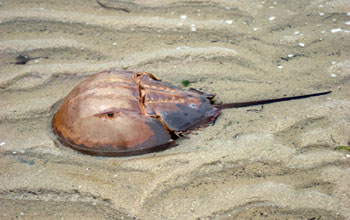All Images
News Release 11-102
Replacing the Blue Bloods
Liquid crystal droplets could replace horseshoe crab blood in common endotoxin test
This material is available primarily for archival purposes. Telephone numbers or other contact information may be out of date; please see current contact information at media contacts.

A recent discovery involving liquid crystals could lead to a replacement test for the presence of endotoxins. Current tests involve the use of horseshoe crab blood, which is blue due to a protein called hemocyanin, the oxygen-carrying pigment the blood contains. This image shows a horseshoe crab in sand at Monomoy National Wildlife Refuge, Mass.
Credit: Bill Perry, U.S. Fish and Wildlife Service
Download the high-resolution JPG version of the image. (673 KB)
Use your mouse to right-click (Mac users may need to Ctrl-click) the link above and choose the option that will save the file or target to your computer.
These polarized side by side videos show droplets of liquid crystal dispersed in water, before and after the addition of endotoxin. The left half of the video shows the appearance of the droplets before endotoxin is added, and the right half of the video shows the appearance of the droplets after endotoxin is added. The schematic illustrations show the interpretation of the ordering of the liquid crystal inside the droplets.
Credit: Daniel S. Miller and Nicholas L. Abbott, University of Wisconsin-Madison

The researchers' work is described in the May 19, 2011 issue of the electronic publication Science Express.
Credit: Copyright AAAS 2011
Download the high-resolution JPG version of the image. (1.2 MB)
Use your mouse to right-click (Mac users may need to Ctrl-click) the link above and choose the option that will save the file or target to your computer.


